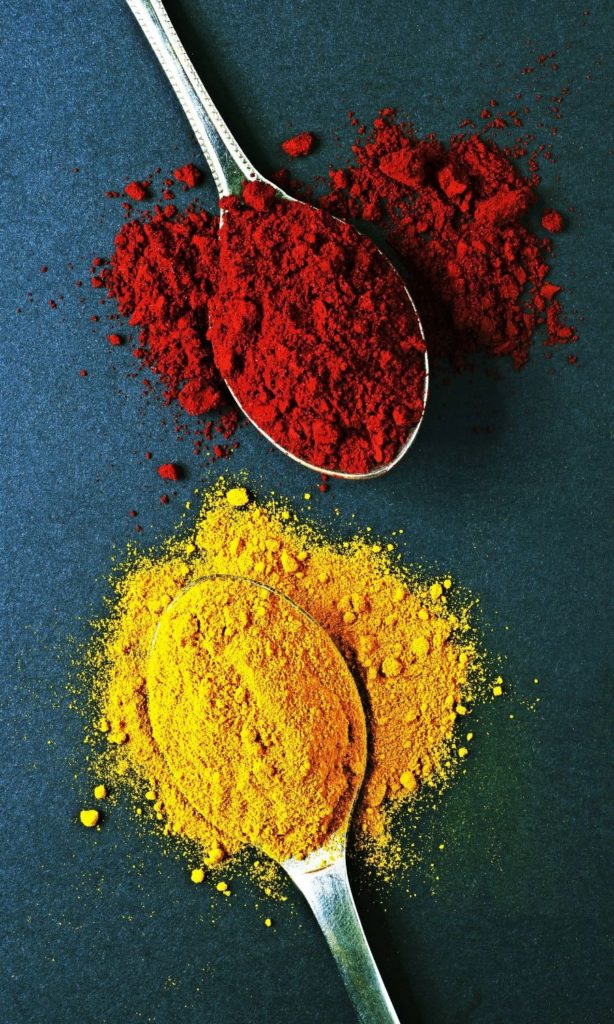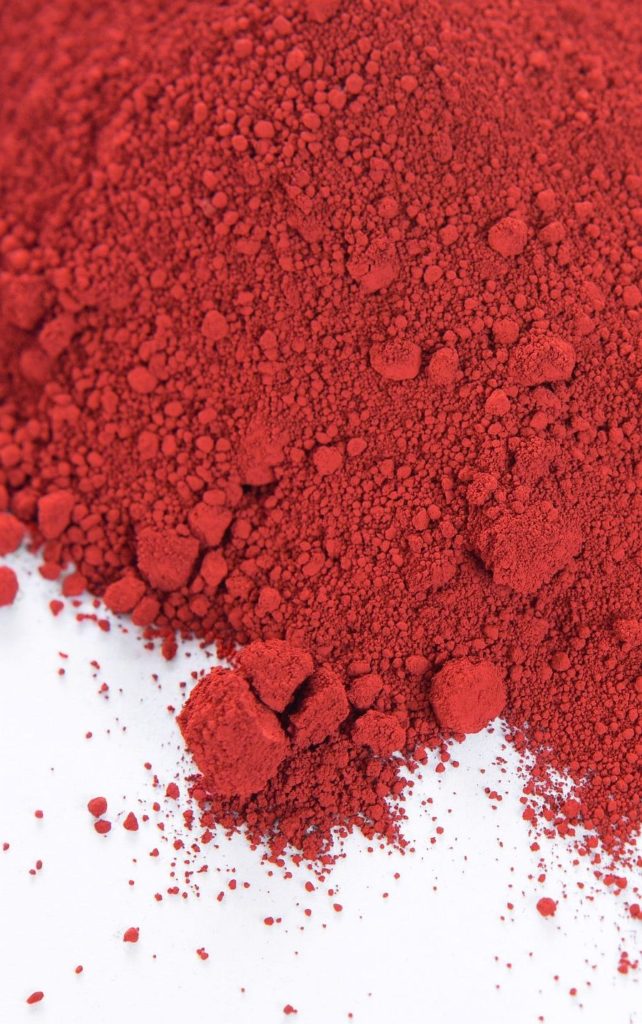In this article, we’ll talk about artificial colors in dog food. You’ll learn what color additives are, how they have to be labeled on dog food, and if (or why) you should avoid them.
Contents
What is a Color Additive?
Color additives are a type of food additive. They include dyes, lakes, pigments, or other substances.
There are many natural pigments that can be sourced from plants, minerals, algae, or animals.
Synthetic colors, on the other hand, are often produced based on by-products from petroleum processing.
Manufacturers can not just use any color they dream up in pet foods. Color additives have to be approved in the Code of Federal Regulations administered by the FDA[7,13].
The purpose of a color additive is to enhance the appearance of your dog’s meal or to compensate for natural color variations. Food dyes replace or accentuate dog food color.
So while manufacturers highlight that color just “adds variety“, it mainly serves to fool you. See, kibble mainly made from soy or grains doesn’t look exactly meaty. But that’s what they want you to believe.

The thing is…
Food coloring does absolutely nothing for your dog!
But it can have a big impact on whether consumers like a product[4]! That’s because we tend to associate color with the flavor or nutritional value of a product[8].
Manufacturers try to produce a more desirable color.
And that can get a little deceptive…
For example, some iron oxide or blue 1 can make your dog`s food look a lot “meatier” than it actually is …
Color additives are not really necessary, except to please the pet owner’s eye.
FDA on Label Claims
Color additives in dog food may be artificially synthesized or extracted as natural colors from a vegetable, animal, or mineral.
Some examples of synthetic color additives are iron oxides, titanium dioxide, and FD&C colors like red 40.
And natural colors are not always better or any less susceptible on a food label, they include things like carmine or caramel.
More and more manufacturers switch to so-called “natural colors” although they are often less vibrant or shelf-stable than synthetic ones. And in many cases, not quite as natural as they sound.

By the way…
Real ingredients that incidentally contribute some of their natural colors to the food like carrots, cranberries, or spinach are not regarded as additives and don’t have to be labeled as such.
Oddly enough, these are the natural pigments we think of when we read “natural color” on the label. But in fact, these very ingredients are not considered color ingredients at all.
Only a substance or extract that is consciously added as a food dye and listed in the Code of Federal Regulations as a color additive like beet juice or turmeric is a color additive.
Natural Colors in Dog Food
Under current FDA regulations, food dyes used to increase the visual attractiveness of dog food fall into 2 categories:
- Colors subject to an FDA certification process, e.g. red 40, yellow 5
- Colors that are exempt from certification, e.g. caramel, turmeric
See, there are no natural color additives[3].
Neither the US nor the EU has defined what a “natural” food color is. They make no difference between synthetic or natural colors[11]. In fact, all color food additives are artificial by definition[1,7,9].
But since “colors exempt from certification” are sourced from plants, algae, microorganisms, minerals, or animals, we call them “natural“.
And since “colors subject to certification” are petroleum-based chemicals that do not occur in nature, we call them “synthetic“.
Some dog food manufacturers love their synthetic colors, they are intense, cheap, very shelf-stable, and blend easily.
Natural pigments, on the other hand, are weaker in color, less stable, and don’t blend as well[3,8,9].

Still, consumer demand for more natural ingredients motivates more and more food suppliers to ditch synthetic colors and substitute them with natural pigments.
Not because they care, but because there is an ongoing trend toward clean labels and natural claims.
Yes, natural colors can be less bad compared to synthetic ones. But they are not always as wholesome as they sound:
Many natural colors are in fact synthetic or chemically modified to the extreme. Many of them are man-made by following their natural examples (aka nature-identical).
For example, beta-carotene used as a food color is not sourced from fruit and veggies but industrially synthesized.
Natural colors are not always better.
They include controversial stuff like caramel or synthetic iron oxide. Sometimes they are preserved with ethoxyquin[3]. They don’t get evaluated by the FDA. They often lack clear definitions and there is no real safety or quality control.
A 2017 study warned that this opens the door for label fraud and misuse of the term “natural” to potentially serious cases of contamination from raw material sources[10].

Why It’s Best to Avoid Color Additives
So, food dyes help guarantee a uniform or more attractive kibble color.
But added colors or flavors are not exactly features of natural dog food made from real ingredients… And natural dyes are not always the dog-friendly food coloring they are portrayed to be.
Dog food is a convenience product and consumers expect a consistent quality and appetizing look when they open a package of dog food.
Food colors are used almost exclusively in foods with low nutritional value, and many of them are controversial ingredients. And just because a color is labeled as natural doesn’t mean it is safe.
As a good rule of thumb, we recommend to just avoid all dyed foods.
At the end of the day, adding color is about us consumers ranking the quality of a product higher than it probably is.

Color additives are often used to imitate real ingredients. They make dog foods look like they are filled with fresh meat or vegetables.
Color adds variety and richness where there’s none and makes the food look like something it’s not.
Based on consumer demand, manufacturers try to replace synthetic dyes with “natural colors”. But it’s not always easy to draw a line between synthetic, natural, or man-made nature-identical dyes.
While “natural” dyes are often just less bad, they’re still not good.
So naturally, if you spot artificial colors on your dog’s food label, some questions come to mind:
Is it safe for my dog to eat? And why does the food need to be enhanced in the first place?
Color additives used in the United States must first be approved by the FDA. And all approved additives are considered safe.
So overall, color additives are strictly regulated. They are used only in tiny amounts that are considered safe by most authorities.
Even allergic reactions to color additives seem to be very rare.
In the past, however, there have been repeated updates on the safety of food dyes that had previously been classified as safe.
And in other countries, some colorants may be viewed differently … like the ban on titanium oxide as a food coloring in the EU.
And there are lots of other food additives that are approved for consumption in the US but not in the EU and vice versa.
That doesn’t inspire much confidence, does it?
Also, artificially synthesized food dyes like red 40, red 3, blue 1, yellow 5, or yellow 6 are highly controversial ingredients and can be harmful to[5]! Why tolerate them in your dog’s food?
Most manufacturers deny that food additives are problematic.
Luckily, due to consumer demand for more natural products, there is an ongoing trend to replace synthetic dyes.
It is generally believed that natural colors are better from a health point of view. However, natural colors in dog food have actually rarely even been tested for safety!
In conclusion, no added color seems to be the overall best option!
Considering additives add zero nutritional benefits…
You or your (somewhat color-blind) dog won’t miss out if you just avoid at least the synthesized ones as best as you can!
Labeling of Color Additives in Dog Food
In the US, each ingredient on the label of dog food has to have a specific name including colorants:
The label of an animal food to which any coloring has been added shall declare the coloring in the statement of ingredients.
21 CFR § 501.22
But color additives fall into one of two categories:
- Dyes that must be certified have to be listed by name.
- Dyes without certification can be listed under an umbrella term like “added color” or “artificial color”.
The restricted color additives subject to certification are synthetic colors usually made from petroleum or coal sources[1]:
These color additives listed in the Federal Food, Drug, and Cosmetic Act are sometimes called FD&C colors. They are cheap, vibrant, stable and predictable.
At least manufacturers have to print on the dog food label whether they have used any of these substances:
A color additive […] subject to certification […] shall be declared by the name of the color additive […]
21 CFR § 501.22
What if the color additives a manufacturer uses are derived from natural sources?
In this case, they don’t have to be certified and they may be combined under a generic group term[1].
As long as he uses only these approved natural colors, the manufacturer simply has to print a general notification on the label:
- Annatto Extract
- Apocarotenal
- β-Carotene
- Beet Powder
- Canthaxanthin
- Caramel
- Carmine
- Carrot Oil
- Cottonseed Flour
- Curcumins
- Fruit Juice
- Paprika
- Riboflavin
- Saffron
- Synthetic Iron Oxide
- Titanium Dioxide
- Tomato Lycopene
- Turmeric
- Vegetable Juice
Most often, you’ll never know which color was actually used:
Color additives not subject to certification may be declared as “artificial color,” “artificial color added,” “color added,” […] “colored with …” or “… color” […].
21 CFR § 501.22
We hope you now have a good overview of dyes in dog food. In summary, they are not all bad, but none of them is good.
Further Reading
[1] Animal foods; labeling of spices, flavorings, colorings, and chemical preservatives. 21 CFR § 501.22
[2] Regulation (EC) No 1831/2003 […] on additives for use in animal nutrition. https://eur-lex.europa.eu/legal-content/EN/TXT/?uri=CELEX:32003R1831
[3] Color Additives Used in Animal Food (PDF). Presented at the AAFCO 2014 Mid-year Meeting. Mika Alewynse, FDA/CVM
[4] Di Donfrancesco et al. Consumer Acceptance of Dry Dog Food Variations. Animals. 2014. https://doi.org/10.3390/ani4020313
[5] Kobylewski & Jacobson. Toxicology of food dyes. International Journal of Occupational and Environmental Health. 2012. https://doi.org/10.1179/1077352512Z.00000000034
[6] Oplatowska-Stachowiak & Elliott. Food colors: Existing and emerging food safety concerns. Critical Reviews in Food Science and Nutrition. 2017. https://doi.org/10.1080/10408398.2014.889652
[7] 21 CFR §501.22(k) on labeling of colorings in animal foods.
[8] Sigurdson et al. Natural Colorants: Food Colorants from Natural Sources. Annu Rev Food Sci Technol. 2017. https://doi.org/10.1146/annurev-food-030216-025923
[9] Wrolstad & Culver. Alternatives to those artificial FD&C food colorants. Annu Rev Food Sci Technol. 2011. https://doi.org/10.1146/annurev-food-022811-101118
[10] Simon et al. Establishing Standards on Colors from Natural Sources. J Food Sci. 2017. https://doi.org/10.1111/1750-3841.13927
[11] Lehto et al. Comparison of food colour regulations in the EU and theUS: a review of current provisions. Food Additives & Contaminants: Part A. 2017. . https://doi.org/10.1080/19440049.2016.1274431
[12] Center for Science in the Public Interest. Artificial colorings (synthetic food dyes). 2022.
[13] AAFCO on Pet Food Additives.
